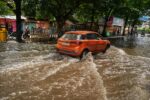Severe Heatwave Alert: 10 Mistakes to Avoid in Extreme Temperatures

Heatwaves are no longer rare, isolated events. They’re becoming more frequent, intense, and prolonged due to climate change. In recent weeks, many parts of the world, including South and Southeast Asia, have been placed under a severe heatwave alert, warning citizens of dangerously high temperatures that can threaten public health, strain infrastructure, and overwhelm emergency services.
Many people unknowingly make mistakes that can put their health at serious risk. From underestimating how heat affects the body to overlooking vulnerable family members, awareness is key. This guide covers 10 of the most common heat-related mistakes—and how to avoid them.
10 Mistakes to Avoid in Extreme Temperatures
Mistake #1: Going Outdoors During Peak Heat Hours (10 AM–4 PM)
Even without a severe heatwave alert out, sun exposure during peak heat hours can quickly lead to dehydration and heatstroke. Try to schedule any necessary outdoor activities for early morning or late evening when temperatures are lower.
Mistake #2: Not Drinking Enough Water
Many people underestimate how quickly their bodies dehydrate in the heat. Stick to water, avoid sugary drinks and alcohol, and sip consistently throughout the day—even if you’re not feeling thirsty.
Mistake #3: Wearing the Wrong Clothing
Dark, tight, or synthetic clothing can trap heat. Instead, opt for loose-fitting, light-colored, and breathable fabrics like cotton or linen. Hats and sunglasses also offer crucial sun protection.
Mistake #4: Over-Relying on Fans Instead of Air Conditioning
Fans may move air around, but in extreme heat, they don’t actually cool the body. If AC isn’t available, consider visiting public cooling centers, libraries, or malls to lower your body temperature.
Mistake #5: Ignoring Early Symptoms of Heat Illness
Dizziness, heavy sweating, muscle cramps, and headaches are warning signs of heat exhaustion. Ignoring them can lead to heatstroke, a life-threatening condition that requires immediate medical attention.
Mistake #6: Exercising or Doing Physical Labor Outdoors
Vigorous activity under high heat is a recipe for heat illness. If exercise is necessary, move it indoors or limit it to early morning hours when temperatures are safer.
Mistake #7: Not Checking Official Heat Alerts
Many people rely solely on how they feel or how the weather “looks” outside. Always check your local weather service or apps for heatwave alerts and warnings, which are based on expert data and forecasts.
Mistake #8: Leaving Children, Pets, or Electronics in Parked Cars
During a severe heatwave alert, temperatures inside parked vehicles can skyrocket to lethal levels in just minutes, even if the windows are slightly open. Never leave children, pets, or even electronics like laptops or power banks in the car unattended. Treat every stop as if it’s urgent to empty the vehicle.
Mistake #9: Eating Heavy, Salty, or Spicy Meals
It’s tempting to go for comfort food, but during a severe heatwave alert, the wrong diet can strain your body further. Heavy meals, salty snacks, and spicy foods can raise body temperature and increase dehydration. Stick to lighter meals rich in water content, like fruits, salads, and soups.
Mistake #10: Assuming You’re Not at Risk Because You’re Young or Fit
A severe heatwave alert is a signal for everyone to take precautions, not just children or the elderly. Even healthy, active adults are at risk of heatstroke if they push themselves too hard or ignore hydration. Overconfidence can lead to dangerous missteps during extreme temperatures, especially for athletes or outdoor workers.
How to Spot Heat-Related Illnesses Early
Recognizing the symptoms of heat-related illnesses can save lives. Heat exhaustion symptoms include heavy sweating, weakness, nausea, headache, and fainting. If untreated, this can progress to heatstroke, which is marked by confusion, a high body temperature (above 103°F / 39.4°C), a rapid pulse, and unconsciousness.
If someone shows signs of heatstroke:
- Call emergency services immediately.
- Move them to a cooler place.
- Use cool cloths or a bath to lower their temperature.
- Do not give fluids if they are unconscious.
Knowing these signs and acting fast can prevent a medical emergency from becoming fatal.
Protecting Vulnerable Populations
Certain groups are far more susceptible to heat-related illnesses when a severe heatwave alert is in effect. Infants and young children, older adults, people with chronic illnesses (like heart disease or diabetes), and pets all require special attention. Their bodies don’t regulate temperature as efficiently, putting them at greater risk for dehydration and heatstroke.
Key tips:
- Check on elderly neighbors or relatives frequently.
- Keep children indoors during the hottest hours and ensure they stay hydrated.
- Never walk dogs on hot pavement, and avoid taking them out during peak sun.
- Make sure medications that affect hydration or sweating are reviewed with a doctor.
During a heatwave, compassion and community matter. A simple check-in can save a life.
Staying Cool Without AC: Affordable Alternatives
Air conditioning can be a lifesaver during a severe heatwave alert, but not everyone has access to it. Fortunately, there are practical, low-cost ways to cool down and stay safe indoors.
Try these alternatives:
- Use fans strategically: place a bowl of ice or cold water in front of a fan to blow cooler air.
- Close blinds and curtains during the day to block out heat from sunlight.
- Sleep with damp sheets or place a cold washcloth on your neck and wrists.
- Take cool showers or foot baths to lower your core temperature.
- If local cooling centers or malls are open, spend the hottest parts of the day there.
Even without AC, proactive cooling techniques can significantly reduce the risk of heat-related illnesses.
Conclusion: Staying Safe, Staying Informed
A severe heatwave alert is not just a warning—it’s a call to action. By avoiding these 10 common mistakes, recognizing early signs of heat illness, and taking steps to protect vulnerable groups, you can help ensure your safety and the well-being of others around you.
Extreme heat is a serious threat, but with awareness, preparation, and community support, it’s one we can face together.
Keep your local weather app updated, share this information with family and friends, and most importantly—stay cool, stay hydrated, and stay alert.
Read Also: 11 Shoulder Workout Gym Tips for Stronger Deltoids








